
|
xTuple ERP Reference Guide |
Projects can be created manually or automatically, depending on your needs. To have projects created automatically whenever a new sales order or quote is entered, choose the appropriate setting in your system-level configuration. Otherwise, projects will be created manually. Once created, projects can be linked to sales orders, work orders, and purchase orders.
To create a new project, go to . The following screen will appear:

When creating a new project, you are presented with the following options:
Enter a code to identify the project.
Enter a brief name to identify the project.
Specify the project type.
Enter the account associated with the project.
Specify the project owner.
Identify the user assigned to the project.
Identify the department assigned to the project.
Specify one of the following statuses to characterize the project:
Use this status to indicate that the project has been newly created.
Use this status to indicate the project has not yet begun.
Use this status to indicate the project is in-process. Certain functions, like time and expense reporting, can only be performed against in-process projects.
Use this status to indicate that the project has been deferred.
Use this status to indicate the project is complete.
Projects generated automatically when a new sales order or quote is entered will be assigned the status Undefined at first. To remove this initial status, simply edit a project and assign an appropriate status to it.
Specify a user-defined priority for the project.
Specify the date the project is due.
Specify the start date for the project.
Specify the date the project was assigned. The assigned date automatically populates when the a user other than the current user is assigned.
Enter the date the project was completed. The completed date automatically populates when the document status is changed to Complete.
Subsequent changes to the above dates are tracked under the tab as change log comments. The changelogs include user and time stamp information.
Input the measurement of the project's completion.
Displays the contact currently attached to the project. You may manually override the displayed contact information in the fields below—or use the lookup feature to select another contact.
Use the lookup feature to add a new contact or to select a pre-existing contact linked to the CRM account that the project is related to. Related contact information will display below the name.
On the tab, the following options are available:
Select which of the following project associations should be listed.
Sales orders
Work orders
Purchase orders
Incidents
Checking this box shows completed tasks in the activity list.
The following button is unique to this screen:
Select to generate a Gantt chart bar chart to illustrate the project schedule. The Gantt chart presents the task completion time line in a graphical format.
To view additional information for the project, select the tab. The following screen will appear:

When viewing the additional information for a project, you are presented with the following options:
Specify which of the following order types can be linked to the project.
Select to indicate sales orders may be linked to the project.
Select to indicate work orders may be linked to the project.
Select to indicate purchase orders may be linked to the project.
When viewing the time and expenses summary for a project, you are presented with the following information:
Displays the total task hours budgeted for the project.
Displays the actual task hours used for the project.
Displays the balance difference between budgeted and actual task hours for the project.
Displays the total task expenses budgeted for the project.
Displays the actual task expenses used for the project.
Displays the balance difference between budgeted and actual task expenses for the project.
You can specify customer and billing rate information by project. To specify the customer and billing rate information, select the tab. The following screen will appear:
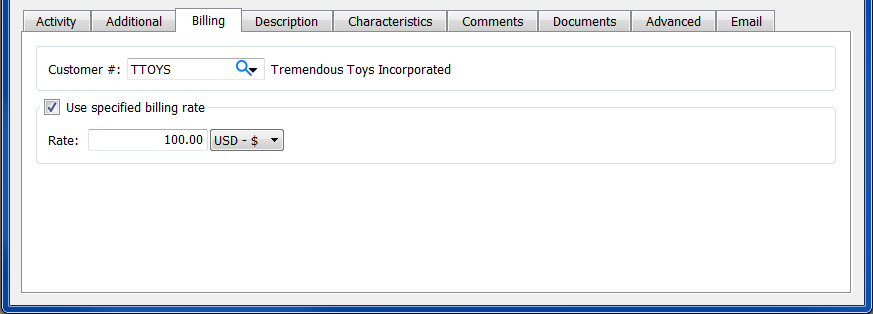
When specifying customer and billing rate information, you are presented with the following options:
Enter the customer you want to associate with the project.
Select if you want to specify a customer billing rate for the project. If not selected, the rate may be entered manually on time sheets.
Specify the customer billing rate for the project.
To add a description of the project, select the tab. The following screen will appear:

Notes entered here are displayed in the Description field when projects are listed.
To add characteristics to a project, select the tab. The following screen will appear:
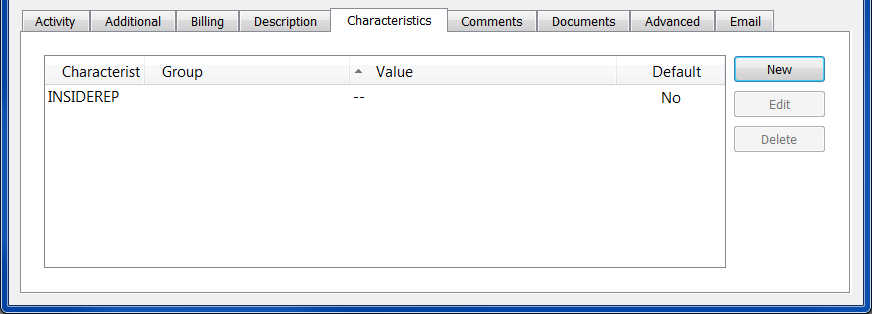
Project Characteristics
To create a new characteristic for your current context, select the button from the characteristics list. The following screen will appear:
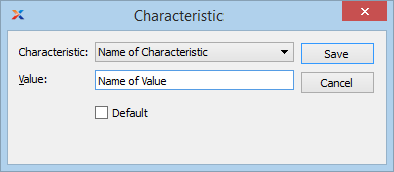
When creating a new characteristic, you are presented with the following options:
Select a characteristic from the list of characteristics available for your current context. To learn more about how characteristics are linked to specific contexts, please see Section 9.2.2.1, “Characteristic”.
Enter a value to associate with the characteristic.
In some contexts, the Default option will appear. Select if the value entered is the default value for the specified characteristic. Default values will always be listed first where characteristics are used.
To add comments related to a project, select the tab. The following screen will appear:

When adding or reviewing comments, you are presented with the following options:
Select to display all comments in the list in an expanded view which includes the entire text of each comment. To edit a comment, simply select the link next to the comment. That link will not be shown for changelog comments, which can't be edited. If the Verbose Text option is not selected, the comment list will display only header level information for each comment.
Display lists comments related to the record.
The following buttons are available:
Opens screen for creating a new comment.
Highlight a comment and then select this button to reach a read-only view of the Edit screen.
Enables you to edit highlighted comments—as long as the comments are not changelog comments. ChangeLog comments are system-generated and may not be edited. The Edit screen is the same as that for creating a new comment—except that when editing, the fields will contain comment information. Double-clicking on a comment will also bring you to the editing screen.
To enter a new comment, select the button. The following screen will appear:

Select a comment type from the drop-down list to classify the comment. This is a required step. Comment types may be system-defined (i.e., changelog and general) or user-defined, as described in Section 13.2.3, “Comment Types”. Once you have specified a comment type, begin typing your comment in the main text area. The text area features word-wrapping and scroll-bar support for longer comments.
The following buttons are unique to this screen:
Select to show the complete list (i.e., thread) of comments associated with the record. To hide the list, simply select the button again. The comment thread will show the most recent comment first.
To view the documents associated with a project, select the tab. The following screen will appear:
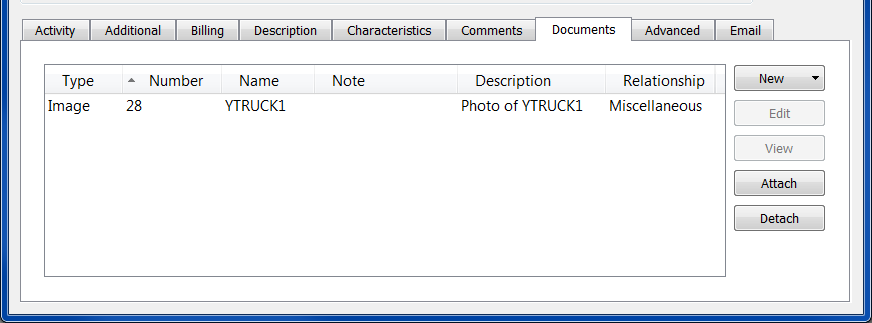
When associating documents, you are presented with the following options:
Select to create a new document and associate it with the current record. You may create the following document types:
Select to create a new image association.
Select to create a new fixed asset association.
Select to create a new maintenance order association.
Select to create a new incident and associate it.
Select to create a new project and associate it.
Select to create a new opportunity and associate it.
Select to create a new task and associate it.
Enables you to edit associated documents. The Edit screen is the same as that for creating a new document—except that when editing, the fields will contain document information. Double-clicking on a document will also bring you to the editing screen.
Highlight a document and then select this button to reach a read-only view of the Edit screen.
Select to associate already-existing documents. The following document types may be attached: contact, account, customer, employee, file, image, incident, item, opportunity, project, purchase order, sales order, vendor, web site, work order.
Highlight a document and then select this button to remove the association.
To associate already-existing documents, select the button. The following screen will appear:
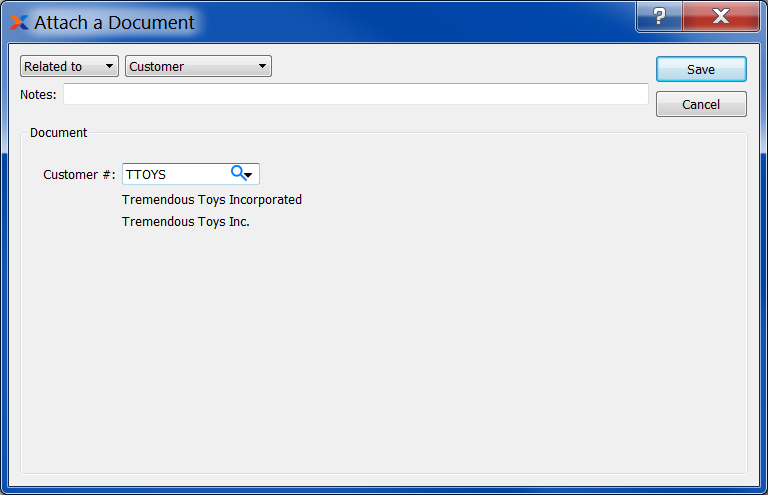
When associating already-existing documents, you are presented with the following options:
Indicate how the document is related to the current record. The following relationship options are available: related to, parent of, child of, duplicate of.
Specify the kind of document you want to associate. The following document types may be attached: contact, account, customer, employee, file, image, incident, item, opportunity, project, purchase order, sales order, vendor, web site, work order. When associating files, you will also be given the option to save the file to the database.
There is no file size restriction when saving files to the database. However, excessively large files could cause storage and performance issues.
Leave any notes on the document file as needed.
Use the lookup tool to identify the specific document you want to attach. The data entry options will vary depending on the document type you select.
To create recurring projects, select the tab. The following screen will appear:
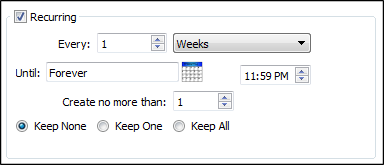
When creating a recurring event, you are presented with the following options:
Check this box if you want the event to repeat itself at regular intervals, using the frequency settings you specify below. Recurring events are generated when you run the Recurring Items utility, which is described in more detail here: Section 10.2, “Create Recurring Items”.
Enter a number and select a unit of time to describe how frequently you want the event to occur. You can choose any regular schedule, ranging from once every 1 minute to once every 99 years.
Enter a date and time at which to start the first event. The default value is the time the screen opened. The From option only appears on some screens.
Enter a date and time after which the event should no longer occur.
Enter the maximum number of future copies of this event you want the system to maintain. Whenever the Create Recurring Items screen is run, it will create up to the number you enter here.
If you delete all copies of a recurring event, the event will stop repeating even if the until date has not yet been reached. xTuple recommends setting this to at least 2 to reduce the likelihood of deleting all copies of the event.
Select to make the next job catch up if work was missed.
Select to create one catch-up job if work was missed.
Select to create any missed jobs.
To view email associated with a project, select the tab. The following screen will appear:
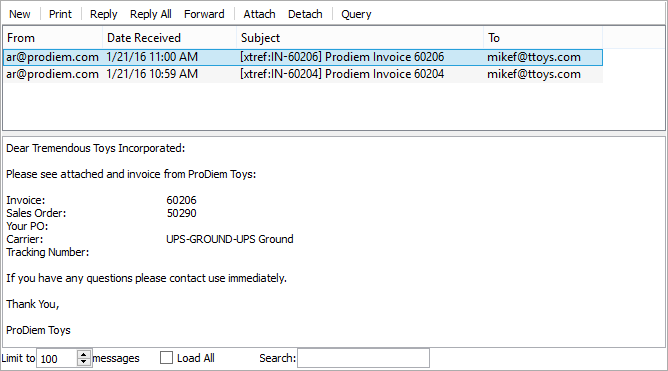
When viewing associated emails, you are presented with the following options:
Display lists associated emails.
The content of a highlighted email will be displayed here.
Specify the maximum number of associated emails you want to be displayed in the email list. If the list is extremely long, you may experience some slowness when opening the screen.
Select to load all associated emails into the list.
Enter a string of letters or complete words to search for matches in the list of associated emails. The search will scan through subject lines, To addresses, and From addresses.
The following buttons are unique to this screen:
Select to send a new email, using the default email program on your computer.
Highlight an email and then select this button to print a copy of the email.
Highlight an email and then select this button to reply to the email's sender, using the default email program on your computer.
Highlight an email and then select this button to reply to everyone associated with the email, using the default email program on your computer.
Highlight an email and then select this button to forward the email to another person(s), using the default email program on your computer.
Highlight an email and then select this button to attach an email associated with a contact in your contact list.
Highlight an email and then select this button to remove the associated email from the list.